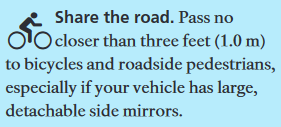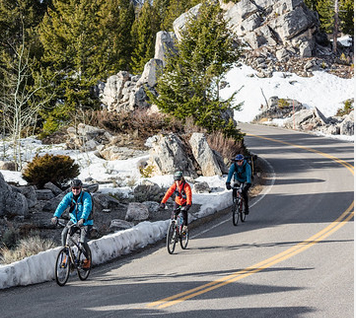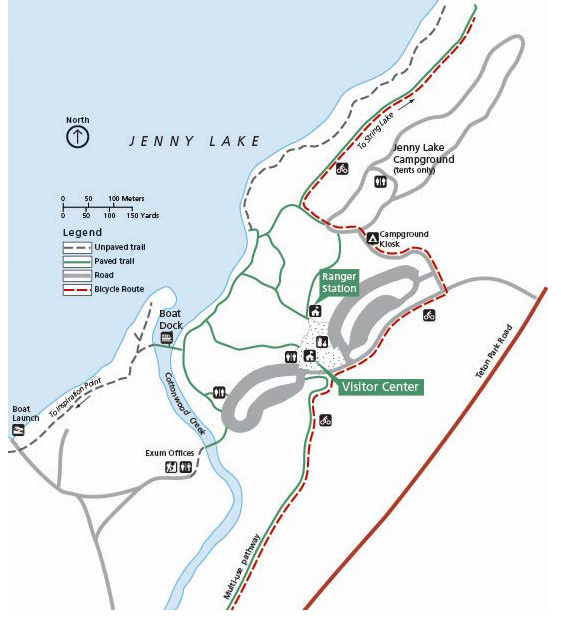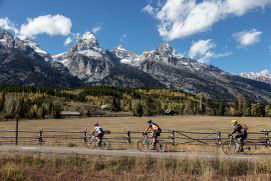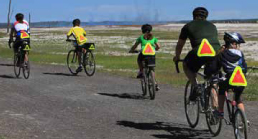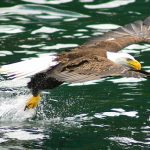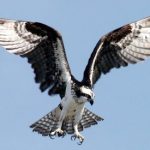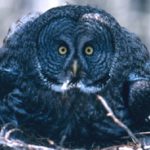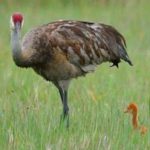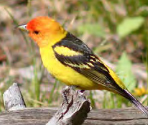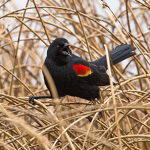This is information about cycling and mountain biking in Grand Teton National Park and the Jackson Hole, Wyoming, vicinity for De Anza College Outdoor Club trips. It can’t be kept completely up to the minute, so check with Rangers for the most current rules and any trail closures, especially due to animal activity.
Bike riding in Grand Teton park can be as safe as at home, but has a few risks different and greater than in other places.
Please note that vehicles on the road will be very busy watching the scenery, not you on your bike.
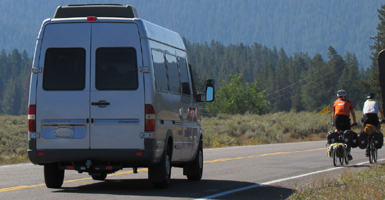
and they have big wide rear-view mirrors sticking out to the side,
drivers (especially drivers of rental camper/vans) who are not used to the size of their vehicle, can hit you.
Riding on the main highway with it’s often narrow shoulders could be dangerous.
Yellowstone warns: “Motorists frequently do not see bicyclists or fail to give them sufficient space on the road. Drivers sometimes pass on hill crests, blind curves, or in oncoming traffic. Vehicles, especially motor homes or those towing trailers, may have wide mirrors, posing an additional hazard.”
A driver going even a bit fast coming around this curve might not see the cyclists until it is too late to stop in time or swerve to miss hitting them (and drivers coming in the opposite direction should anticipate an oncoming driver swerving into their lane):
The park service warns:
“Some roads in the park predate today’s bicycling popularity. Most roads have a paved marked shoulder, providing limited space for safe bicycling. Some roads have only a very narrow shoulder, or lack one altogether. Use extreme caution.” . . .”Riding a bicycle abreast of another bicycle on paved roads within the park and parkway is prohibited. Ride single file for your safety and compliance. During low visibility and between sunset and sunrise, bicyclists must display a white light or reflector from the front and a red light or reflector from the rear. Drivers are often distracted when driving through the park, ride defensively.”
Vehicles kill dozens of animals every year in the Tetons and Yellowstone despite warnings:

Don’t bike or jog/run by yourself, it is safer to bike in groups since there are very large, potentially dangerous and unpredictable animals potentially everywhere.
Please, no trail running Grand Teton National park: “Trail running is strongly discouraged; you may startle a bear.” Glacier National Park: “Trail running is discouraged as there have been an increasing number of injuries and fatalities due to runners surprising bears at close range.”
– – – – – – – – – – – – – – – – – – – – – – – – – – – – – – – – – – – – – – – – – –
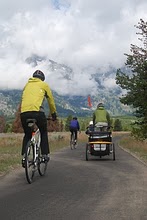
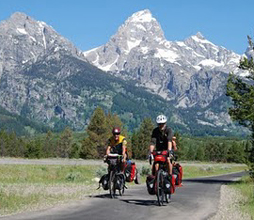 It is safer to enjoy a bike ride on a designated bike/roller blade/walk path like the Teton multi-use pathway, than on the road/highway with drivers looking at scenery instead of you on your bike, and it is safer for you to stop and take in the scenery.
It is safer to enjoy a bike ride on a designated bike/roller blade/walk path like the Teton multi-use pathway, than on the road/highway with drivers looking at scenery instead of you on your bike, and it is safer for you to stop and take in the scenery.
There is an 8 mile long pathway (Grand Teton Pathway) from South Jenny Lake to the Moose Visitor Center, then into town.

Here is a map of the multi-use pathway (paved bike route), the red dotted line, through the south Jenny Lake area. Note that the green lines are paved walking trails. In some parts (green lines and red dotted lines together) they are are shared by hikers, pedestrians and bike riders, but where the line is green only, you should not ride a bike, but might be able to find enough room to walk your bike:
Here is a Google maps photo of where the bike pathway enters the South Jenny Lake parking lot area from the south (right hand side of the photo), with lots of bike racks. The store, restrooms and visitor center are on the left of the photo.
And here, another map of the south Jenny Lake area, with the multi-use pathway coming in from the left and the bike parking area marked with a red dot:
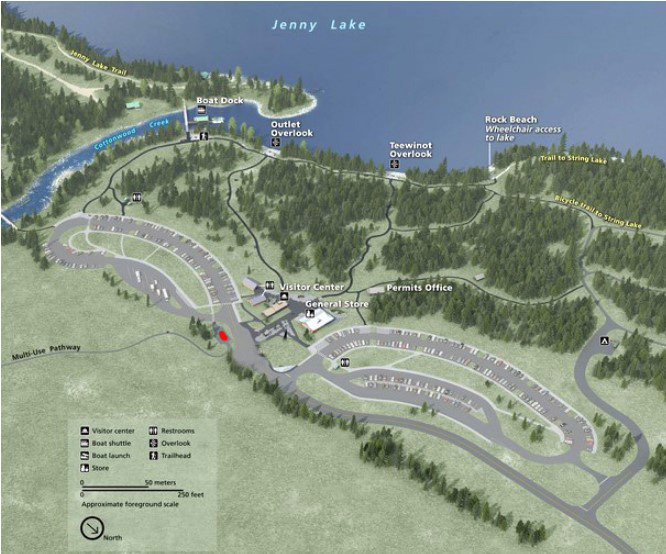
After Jenny lake, going south, the pathway runs along the Teton park Road (TPR). Well south of the Taggart Lake parking lot the pathway goes across Teton Park Road (TPR) with a crosswalk that many drivers ignore stopping for, that you can see in this Google maps photo.
After going around in the Moose area, including at the main visitor center parking lot, the pathway goes under the highway and into town along the east side of highway 191/89/26. (This section is usually closed Dec. 1 to April 30 to protect migrating elk.)
Here is a Google maps picture of the bike/pedestrian underpass when the bike pathway goes under the highway when it gets to Teton park road near the Moose entrance station.
Please walk your bike in the parking lots. Bikes yield to others.
It has been estimated that the bike route
from Jackson to Moose (if you choose a route that is 26 miles round-trip) can take 3 hours.
Moose to Jenny Lake, 15 miles round trip, 1 1/2 hours.
Bike pathways in Grand Teton National Park have displays with maps and descriptions of nearby facilities:
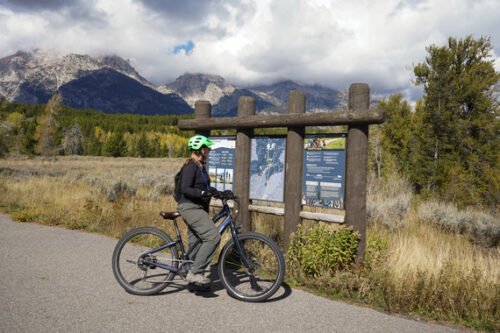
Only NON-MOTORIZED METHODS of transportation are permitted on the multi-use pathway. Persons with physical disabilities may use electric and battery operated transportation. Pets (except guide dogs) are prohibited and the pathway is closed from dusk to dawn for wildlife and public safety. The pathway is open whenever it is predominantly free of snow and ice.
Whoooooa, stay alert. . . occasionally a driver gets lost and ends up driving on the bike pathway.
Use hand signals as appropriate and announce your presence before passing (you could say something like ‘passing on your left’ as you approach a pedestrian, slower biker, or someone stopped by the side of the pathway).
Never leave food unattended, including food in bike panniers and backpacks.
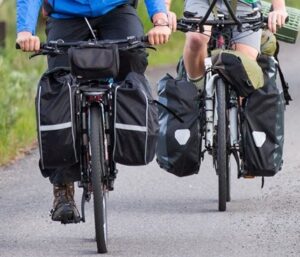
The NPS warns: “Zippered Bike Bags Aren’t Secure
All food, trash, and scented items must be kept inaccessible to wildlife at all times and stored securely. Be aware that in some areas, ravens have learned to unzip packs and bike bags and scatter the contents.”
– – – – – – – – – – – – – – – – – – – – – – – – – – – – – – – – – – – – – – – – – –
The National Highway Traffic Safety Administration says:
BE PREPARED BEFORE HEADING OUT
Pre-Ride Check
Ride a bike that fits you—if it’s too big, it’s harder to control the bike.
Ride a bike that works—it really doesn’t matter how well you ride if the brakes don’t work.
Wear equipment to protect you and make you more visible to others, like a bike helmet, bright clothing (during the day), reflective gear, and a white front light and red rear light and reflectors on your bike (at night, or when visibility is poor).
Ride one per seat, with both hands on the handlebars, unless signaling a turn.
Carry all items in a backpack or strapped to the back of the bike.
Tuck and tie your shoe laces and pant legs so they don’t get caught in your bike chain.
Plan your route—if driving as a vehicle on the road, choose routes with less traffic and slower speeds. Your safest route may be away from traffic altogether, in a bike lane or on a bike path.”
– – – – – – – – – – – – – – – – – – – – – – – – – – – – – – – – – – – – – – – – – –
Teton-based mountain bikers has advice for using mountain biking trails:
“Don’t forget appropriate protection: a full-face helmet, knee and elbow pads, and eye protection at a minimum; back and chest protectors are recommended.”
________________________________________________________
In 2022 “The popular Scenic Drive” (3 mile / 4.8 km long) “that starts at String Lake in the north, continues south along Jenny Lake and connects to Teton Park Road was restriped to allow for one-way vehicle traffic and two-way bicycle traffic. The existing southbound bicycle lane was widened to allow for bicycles and vehicles and a new northbound lane was created for bicycles only.”
see the one-way road in the map below:
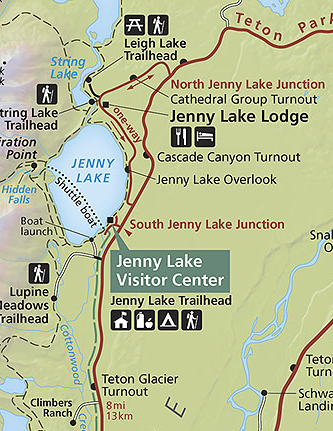
At one end of the scenic drive where it connects to the Teton Park Road, you will see Wrong Way (do not enter) signs for automobiles, but also see arrows showing it is okay for bikes to enter, since the road is one-way for autos/truck/RVs and 2 way for bicyclists.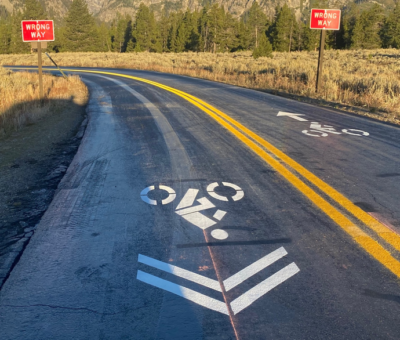
This was how it looked before the striping to make it two-way for bicycles:
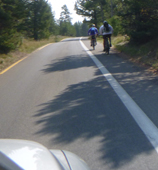
and how it looks now: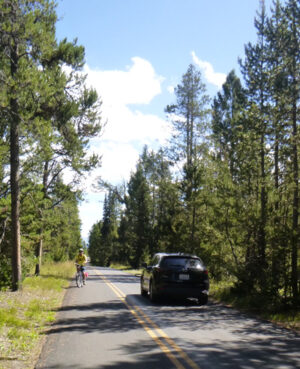
As you drive, bike or hike this route you are on the terminal moraine of the Jenny Lake Glacier that formed the lake. There is a small parking lot right above the lakeshore on the right hand side with this view across to Cascade Canyon:
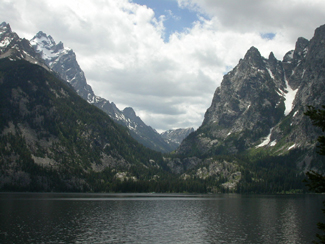
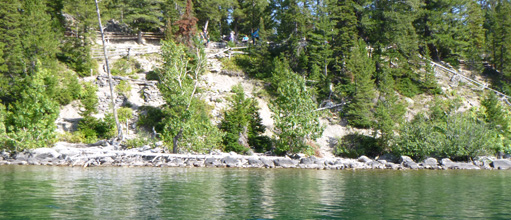
The Jenny Lake Scenic Drive rejoins the Teton Park Road near South Jenny Lake. If you decide to bike out on the highway, watch out for people on the Teton Park Road trying to turn onto the one-way road you are leaving.
________________________________________________________
Grand Teton National park has an announcement that some park visitors seem to not have learned about:
“Be thoughtful of how music may affect others. Operating an audio device, such as a stereo, Bluetooth speaker, radio, or musical instrument in a manner which is unreasonable and impacts park users is prohibited by law.”
Bike helmets are required for biking on De Anza Outdoor Club trips, at all times (all ages of riders), even if bike riding is not an official part of the trip.
– – – – – – – – – – – – – – – – – – – – – – – – – – – – – – – – – – – – – – – – – –
The Centers for Disease Control and Prevention (CDC) says:
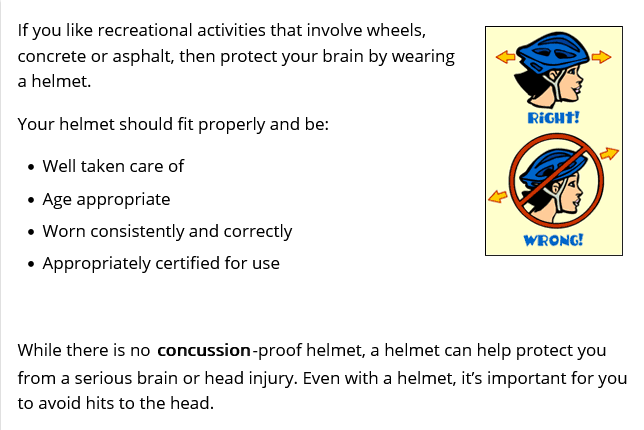
Wearing your bike helmet over a baseball cap or hat to give you shade is not advised,
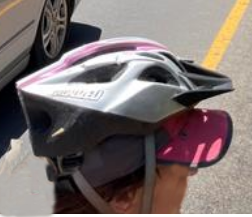
the helmet needs to be firmly on your head to protect you.
You can get a wide brim to put over your helmet like Park Service Search and Rescue Rangers wear
(be sure to get one that does not interfere with your peripheral vision):
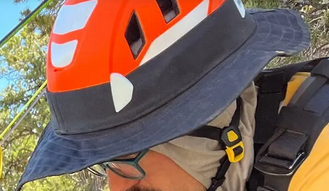
According to a report in the American Journal of Surgery, bike riders with helmets were less likely to die from their injuries, and less likely to break facial bones, and have 52 percent lower risk of severe traumatic brain injury.
Unfortunately, less than half of the millions of Americans who ride bicycles wear bicycle helmets. Those who do wear them are more likely to be white, female and insured.
(In Australia, Finland, New Zealand, Dubai, parts of Canada and many other places, bicycle helmets are mandatory in all states and territories for all ages.)
Many professionals wear helmets, including competitive skiers and rodeo cowboys.
Yosemite Search and Rescue would like to remind you: “California law requires riders under 18 to wear helmets. Helmets are optional for bicycle riders 18 and over but they are an outstanding idea, inexpensive, and in many cases are the difference between a minor headache and life-altering or life-ending injuries. Unfortunately, when one observes bicycle operations in the Valley, the majority of adult bike riders, and even some children, opt to skip the helmet. Once the crash occurs, it’s too late to reconsider your decision to skip the helmet.”
This quote is from:
https://www.nps.gov/yose/blogs/frontcountry-biking-accident-halts-visitors-backcountry-plans.htm
Grand Teton Park says: “Helmets and bright-colored clothes are recommended due to heavy traffic.”
– Glacier National Park said about biking in cold / rain:
“Windbreakers or rain shells over thin insulated jackets are good layers to bring for possible inclement weather conditions.
A thin, neoprene hat will help keep your head warm, and it will fit under a helmet.
Gloves and neck gaiters assist greatly with retaining warmth.
Bring additional dry and warm layers for after your ride.”
Neoprene is a close-cell synthetic-rubber material that is commonly used in wetsuits and to make an extra thick swim cap an open-water triathlete might wear: closed-cell 3 millimeters thick. Look for a flexible chin strap or you can buy one without a chin strap.
It should fit comfortably under your bike helmet (and climbing helmet) and not interfere with the proper fit of your helmet or your peripheral vision.
– – – – – – – – – – – – – – – – – – – – – – – – – – – – – – – – – – –
Maps of bikeways in the county can be found at:
http://www.tetoncountywy.gov/DocumentCenter/View/4158
Maps of bikeways in town can be found at: http://www.tetoncountywy.gov/DocumentCenter/View/4157 one bikeway runs all the way into Grand Teton park and thru to Jenny Lake.
and see:
Grand Teton https://www.nps.gov/grte/planyourvisit/bike.htm
Yellowstone https://www.nps.gov/yell/planyourvisit/bicycling.htm
– – – – – – – – – – – – – – – – – – – – – – – – – – – – – – – – – – –

– – – – – – – – – – – – – – – – – – – – – – – – – – – – – – – – – – –
As of an article in the Jackson Hole News and Guide, June 2018:
bike riders must come to a full stop at stop signs,
not just slow down and ride thru intersections as they might do in other western states.
. . . “police say the potential ramifications are too great to ignore minor traffic violations.”
“The negative consequences for violating the law and the potential of injury is so high that we think $135 is appropriate for a cyclist running a stop sign,” Schultz said. “I would rather have you hate me for giving you a stop sign ticket than have you hate me for not protecting you from yourself and your family hating me for not doing my job and you getting killed.”
https://www.jacksonwy.gov/280/Police
– – – – – – – – – – – – – – – – – – – – – – – – – – – – – – – – – – –
The Teton Park Road usually first opens after winter closure for non-motorized recreational uses such as walking, bicycling, and rollerblading, between the Taggart Lake Trailhead and Signal Mountain Lodge, in early spring (2022 it was Friday, March 25).
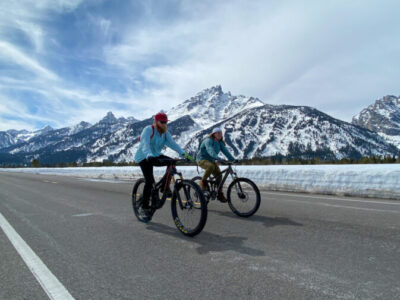
The press release when the road opens often says: “Please use caution, as snow and ice may persist on some sections of the roadway creating slick conditions. Recreationists should also be alert for park vehicles that periodically travel this roadway for administrative purposes as spring opening operations continue. Road crews may be clearing auxiliary roads and wayside areas, and visitors are cautioned to keep a safe distance from rotary plows and other heavy equipment.
Visitors enjoying the Teton Park Road are encouraged to be good stewards of the park and reminded:
Vehicles should slow down and use caution in the area.
Be respectful of other visitors enjoying the area and be thoughtful of how music may affect others. Operating an audio device, such as a stereo, Bluetooth speakers, radio, or musical instrument in a manner which is unreasonable and impacts park users is prohibited by law.
Water is not available at the trailhead or along the road. Be self-sufficient with water, snacks, and bicycle/skate repairs.
Vault toilets are available at Taggart Lake Trailhead and Cottonwood Picnic Area, with portable toilets located along the road between Cottonwood and North Jenny Lake Junction, and restroom facilities at Signal Mountain Lodge.
Pack it in, pack it out. There are limited trash receptacles at both ends of the road. Do not put trash in the portable toilets.
Dogs are permitted on the Teton Park Road. Dog owners are required to use a leash no longer than six feet in length and are required to clean up after their dogs. Waste disposal bag stations are located at each end of the road. Bags should be deposited into appropriate trash receptacles and not left along the road.
Consider beginning at the Signal Mountain end of the road as it is less busy and offers ample parking, restroom facilities, water filling station, and self-pay fuel pumps at Signal Mountain Lodge. Please respect the Signal Mountain Lodge area, as most facilities are not open to the public at this time.
. . . All park visitors should respect road closures and look for signs posted near the road regarding any recreational use or access. For information on park roads, visit https://www.nps.gov/grte/planyourvisit/roads.htm or call 307-739-3682. . .
The paved multi-use pathways in the park are open whenever they are predominately free of snow and ice. Use of the pathway in the park is prohibited from ½ hour after sunset to ½ hour before sunrise. Pets are not permitted on the pathway.”
– – – – – – – – – – – – – – – – – – – – – – – – – – – – – – – – – – –
Maps and rules for Yellowstone biking:
https://www.nps.gov/yell/planyourvisit/bicycling.htm
Park rules say do not approach wildlife, stay 100 yards from bears or wolves and 25 yards from other wildlife including nesting birds. If you have an accidental, surprise or inadvertent closer encounter with wildlife you must remove yourself to those distances.
You can rent bikes in the park, but bringing your own on a vehicle is cheaper.
Drownings are the number one cause of accidental death in the National Park Service. Next to drowning, motor vehicle crashes are the second leading cause of accidental deaths in the National Park Service. One study found that “visitors distracted by scenery was a contributing factor in 27% of all motor vehicle crashes, alcohol was a contributing factor in 23% of the crashes, visitors from Asia and Europe crossing over the centerline to drive on the left side of the road was a factor in 14% of the crashes, excessive speed was the primary factor in 8% of the crashes, and visitors driving off-road and hitting stationary objects or rolling over was the primary factor in 11% of crash fatalities.
Studies suggest that rates of sudden encounters with bears are much higher among cyclists than hikers, due to the speed at which bikers come up on animals. Some of these incidents have been fatal to the human. Read on to find ‘grizzly bears and cyclists’ below.
For your safety hiking, the Rangers warn “Always carry bear spray and know how to use it,” which applies to cyclists as well. your safety in grizzly bear territory tells you what to do if you see a bear in the distance or a bear charges you, has info about Bear Sprays that you should carry even when biking.
From the National Park Service Daily Report of Thursday, September 21, 2006,
Grand Canyon National Park (AZ)
Runner Charged, Struck By Bull Elk
A long-time park resident was running on a trail behind the Albright Training Center between Center Road and the Grand Canyon School around 6 a.m. on September 19th when he was charged by a large bull elk. He saw that the elk was rubbing its antlers on a tree and acting aggressively, so he took evasive action and ran off trail into the woods around it. The elk pursued, though, and knocked him down. He was able to get away and flagged down a passerby, who called for assistance. The runner suffered scrapes and bruises along with an ankle injury and was transported by ambulance to the Flagstaff Medical Center. Park wildlife biologists and rangers will spend the next several days in the area where the incident occurred and will attempt to move the elk out of the area using aversive conditioning. Although encounters with bull elk have not been common within the park, rangers are reminding residents and park visitors that it is rutting season for both deer and elk. During this period, generally September/October, these animals become increasingly aggressive and may become angered by any intrusion into their territory. Elk, which can weigh as much as 1,000 pounds, have been known to injure or kill people who approach them. [Submitted by Maureen Oltrogge, Public Affairs Officer]
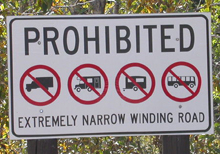
Bikes or other wheeled vehicles are not allowed on hiking trails or in the backcountry on or off trail. They are only allowed in the park on paved and unpaved roads where cars can legally go, on designated bike/walk pathways and (some years) on the Colter Bay Marina breakwater.
The park says about safe biking: ride single file on the right hand road shoulder, use hand signals to communicate with drivers, wear a helmet at all times (all ages of riders). Please also wear highly visible clothing. Bright colored, preferably reflectively enhanced, clothing is best.
Be predictable.
The Park Service does not recommend biking at night , but if you do bike before sunrise of after sunset you will need a forward facing white light/reflector and a rear facing red light/reflector.
Read more at:
http://www.nps.gov/grte/planyourvisit/bike.htm
photo below used with permission from Ron Niebrugge: http://www.wildnatureimages.com/
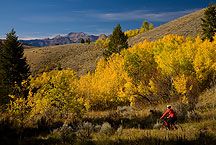
_______________________________________________
Yellowstone biking safety page: http://www.nps.gov/yell/planyourvisit/bicycling.htm
_______________________________________________
The Teton Wilderness and the Gros Ventre Wilderness are much of the land to the east of Grand Teton National Park up to Yellowstone and to the east of and below the town of Jackson. Go to:
http://www.fs.usda.gov/btnf/ click on recreation, then bicycling, then the appropriate section.
Please remember
bikes yield to hikers and horses,
hikers yield to horses.
The local Forest Service office reminds us:
YOU ARE TOO CLOSE TO WILDLIFE IF:
· The animal stops feeding or resting.
· The animal starts moving either toward or away from you.
· The animal starts panting, huffing or making unusual sounds.
· The animal begins pawing the ground or swinging its head.
· Neck hair or feathers stand up.
· The animal appears nervous, uneasy or stressed.
If you notice these signs you are disturbing the animal and it is time
to slowly move away. The safest way to view wildlife is through
binoculars or spotting scopes.”


Grizzly bears and cyclists
The following info is from a study of the effect planned road improvements could have on animals in the park. The study of bears mentioned is from Canadian parks, but the same incidents could happen to cyclists anywhere.
“Some information on cyclist encounters with grizzly bears is available from Herrero and Herrero (2000), from which the following information was taken. In North America, 33 records were found for cyclist encounters with grizzly bears in which the bear responded aggressively. Five of these occurred on roads used by cars and the remaining occurred on trials or nearby.
In most cases grizzly bears charged or chased cyclists. In 12% (4 of 33) of encounters, cyclists were injured by grizzly bears; in 75% of these cases(3 of 4), injuries were serious (requiring more than 24 hours in a hospital).
The majority (22 of 33) of encounters occurred in Banff and Jasper National Parks, where mountain biking is allowed on some trails.
Ninety-five percent of encounters in which distance was estimated, the cyclist first became aware of the bear at less than 50 meters, “which Herrero (1985) defined as a sudden encounter.
Importantly, while not conclusive, the data suggest that rates of sudden encounters with bears are much higher among cyclists than hikers.
“Indeed, in Canada’s Kluane National Park, park managers state that “Mountain bikers travel quickly and quietly on the trails. As a result, they are much more likely to have surprise encounters with bears and other wildlife, than hikers, and horses” (Kluane National Park 1997).
Most of the encounters documented by Herrero and Herrero (2000) and discussed above occurred on dirt trails, where bicycles would be expected to travel slower and make more noise than they would on a paved pathway.”
____________________________________
The Forest Service recommends that if you mountain bike in their areas: SLOW DOWN
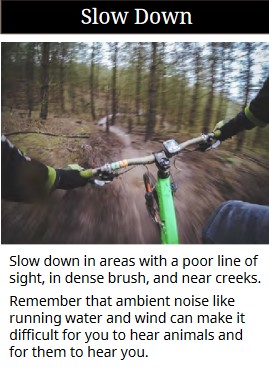
____________________________________
Grizzleys can run as fast as 30 mph in short distances.
Bison can run three times faster than humans can sprint. Bison can spin around faster than a horse.
Don’t count on a bison giving warning. Stay a minimum 75 feet (or more) away from all large animals. See also: Before a bison charges
____________________________________
“Griz Expert Says ‘Mountain Bikes Are A Grave Threat To Bears‘
When it comes to safeguarding bears, scientists say wilderness-caliber lands, free of riders, are important to bruin persistence.”
https://mountainjournal.org/scientists-say-mountain-biking-negatively-impacts-bears
____________________________________
Park rules say do not approach wildlife, stay 100 yards from bears or wolves and 25 yards from other wildlife including nesting birds.
If you have an accidental, surprise or inadvertent closer encounter with wildlife you must remove yourself to those distances, including while driving on a road.
To visualize 100 yards, picture the length of a football field.
To visualize 25 yards, picture four car lengths, six kayak lengths or the width of an Olympic-sized pool like ours at the college.
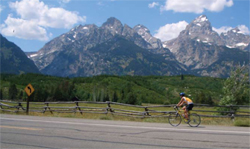
____________________________________
Check out riding in rain and darkness, ways to deal with tough situations, and more at:
http://www.bikexprt.com/streetsmarts/usa/index.htm
your safety in grizzly bear territory tells you what to do if you see a bear in the distance or a bear charges you, has info about Bear Pepper Sprays that you should carry even when biking. Before a bison charges tells what a bison might do before it charges and has details of injuries.
Camping solutions for women has tips for and answers typical questions from first-time women campers, including the question: Can menstruating women camp or backpack around bears? YES.
Grand Teton National Park sightseeing has place to stop at along each of the park main highways, many of them accessible from the bike pathway.
Bears has links to general info about bears, then practicalities of camping and backpacking around bears, (food storage, what to do if you see a bear) mostly geared towards De Anza College Outdoor Club trips around black bears in California.
Some people bring bikes on their vehicles, but there are rentals available as well. Costs are often posted at: Grand Tetons trip cost at the ‘expensive trip’ section.
___________________________________
Grand Teton National Park birds has photos and details about the most common ones we can hope to see
including Bald Eagle, Red-winged Blackbird, Canada Geese, Clark’s Nutcracker, Golden Eagle, Great Blue Heron. Great Gray Owl, Harlequin duck, Loon, Magpie, Merganser, Northern Flicker (woodpecker), Osprey, Ouzel, Pelican, Peregrine Falcon, Ptarmigan, Raven, Sandhill Cranes, Steller’s Jays, Trumpeter Swan , Western Meadowlark, and Western Tanager, with links to calls / songs from most of them to listen to.
and you can Download photos of over a hundred birds of Grand Teton National Park
https://www.audubon.org/climate/national-parks/grand-teton-national-park
___________________________________
For details about the next De Anza College Outdoor Club trip to Grand Teton National Park, go to: Grand Tetons.
Grand Tetons trip pages index has brief descriptions of most of the pages about this trip.
